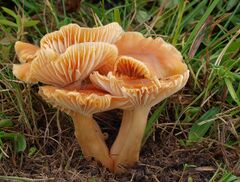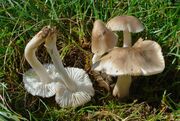Biology:Cuphophyllus
| Cuphophyllus | |
|---|---|

| |
| Cuphophyllus pratensis | |
| Scientific classification | |
| Kingdom: | |
| Division: | |
| Class: | |
| Order: | |
| Family: | |
| Genus: | Cuphophyllus (Donk) Bon (1985)
|
| Type species | |
| Cuphophyllus pratensis (Pers.) Bon (1985)
| |
Cuphophyllus is a genus of agaric fungi in the family Hygrophoraceae. Cuphophyllus species belong to a group known as waxcaps in English, sometimes also waxy caps in North America or waxgills in New Zealand. In Europe, Cuphophyllus species are typical of waxcap grasslands, a declining habitat due to changing agricultural practices. As a result, four species, Cuphophyllus atlanticus (as C. canescens),[1] C. colemannianus, C. lacmus, and C. lepidopus are of global conservation concern and are listed as "vulnerable" on the IUCN Red List of Threatened Species.[2]
Taxonomy
History
The genus was described by French mycologist Marcel Bon in 1985,[3] though it was subsequently synonymized with Hygrocybe by some authorities.[4] Cuphophyllus species have sometimes been referred to the genus Camarophyllus (Fr.) P.Kumm., but, as argued by Donk (1962), the type species of Camarophyllus must be Agaricus camarophyllus Alb. & Schwein. the species from which the genus takes its name.[5] This means that Camarophyllus sensu stricto is a synonym of Hygrophorus, since A. camarophyllus is a Hygrophorus species (Hygrophorus camarophyllus). This is now accepted by all standard authorities.[6][7][4] Singer (1951), however, proposed Agaricus pratensis (= Cuphophyllus pratensis) as the type species of Camarophyllus,[8] which means that Camarophyllus sensu Singer is a synonym of Cuphophyllus.
Current status
Recent molecular research, based on cladistic analysis of DNA sequences, indicates that Cuphophyllus is monophyletic and forms a natural group distinct from Hygrocybe sensu stricto.[9][10][11]
Description
Species are distinguished from most other waxcaps by producing non-viscid, typically white, grey, or brownish basidiocarps (fruit bodies) often with decurrent lamellae (gills). Species of the genus Chromosera are superficially similar, though often more brightly coloured.[4]
Habitat and Distribution
In Europe, Cuphophyllus species are typically found in agriculturally unimproved, short-sward grasslands (including pastures and lawns). Elsewhere, they are most frequently found in woodland. The genus is cosmopolitan.[4]
Economic usage
Fruit bodies of one of the commoner European waxcap species, C. pratensis, are edible[4] and widely collected, sometimes being offered for sale in local markets.
Species
- C. acutoides
- C. adonis
- C. albidocinereus
- C. angustifolius
- C. antillanus
- C. atlanticus
- C. aurantius
- C. basidiosus
- C. berkeleyi
- C. bicolor
- C. bondii
- C. borealis
- C. canescens
- C. cereopallidus
- C. cheelii
- C. cinerellus
- C. cinereus
- C. citrinopallidus
- C. colemannianus
- C. comosus
- C. esteriae
- C. flavipes
- C. flavipesoides
- C. fornicatus
- C. fuscensis
- C. griseorufescens
- C. hygrocyboides
- C. lacmus
- C. lamarum
- C. lepidopus
- C. nebularis
- C. neopratensis
- C. neopratensis
- C. ochraceopallidus
- C. pegleri
- C. pratensis
- C. pseudopallidus
- C. radiatus
- C. rainierensis
- C. recurvatus
- C. rigelliae
- C. roseascens
- C. russocoriaceus
- C. subradiatus
- C. subviolaceus
- C. umbrinus
- C. virgineus
See also
References
- ↑ "Cuphophyllus atlanticus (Hygrophoraceae, Agaricales) — a new sister species to the North American C. canescens". Agarica 42: 39–48. 2021.
- ↑ "Cuphophyllus. The IUCN Red List of Threatened Species". https://www.iucnredlist.org/search?query=cuphophyllus&searchType=species.
- ↑ "Cuphophyllus (Donk) Bon". Index Fungorum. CAB International. http://www.indexfungorum.org/names/NamesRecord.asp?RecordID=25612. Retrieved 2011-12-29.
- ↑ 4.0 4.1 4.2 4.3 4.4 Boertmann D. (2010). The genus Hygrocybe (2nd ed.). Copenhagen: Danish Mycological Society. pp. 200. ISBN 978-87-983581-7-6.
- ↑ Donk MA (1962). "The generic names proposed for the Agaricaceae". Beihefte zur Nova Hedwigia 5: 1–320.
- ↑ "Camarophyllus (Fr.) P. Kumm.". Index Fungorum. CAB International. http://www.indexfungorum.org/names/NamesRecord.asp?RecordID=17228. Retrieved 2011-12-29.
- ↑ "Camarophyllus (Fr.) P. Kumm.". MycoBank. International Mycological Association. http://www.mycobank.org/MycoTaxo.aspx?Link=T&Rec=17228. Retrieved 2011-12-29.
- ↑ Singer R. (1949). "The Agaricales in modern taxonomy". Lilloa 22: 1–832.
- ↑ "Major clades of Agaricales: a multilocus phylogenetic overview". Mycologia 98 (6): 982–95. 2006. doi:10.3852/mycologia.98.6.982. PMID 17486974. Archived from the original on 2016-03-03. https://web.archive.org/web/20160303170605/http://www.clarku.edu/faculty/dhibbett/Reprints%20PDFs/Mathenyetal_Agaricales_2006.pdf.
- ↑ "Preliminary notes on dual relevance of ITS sequences and pigments in Hygrocybe taxonomy". Persoonia 26: 99–107. 2011. doi:10.3767/003158511X578349. PMID 22025807. PMC 3160800. http://www.repository.naturalis.nl/document/570010.
- ↑ "Molecular phylogeny, morphology, pigment chemistry and ecology in Hygrophoraceae (Agaricales)". Fungal Diversity 64 (1): 1–99. 2014. doi:10.1007/s13225-013-0259-0.
Wikidata ☰ Q918158 entry
 |






